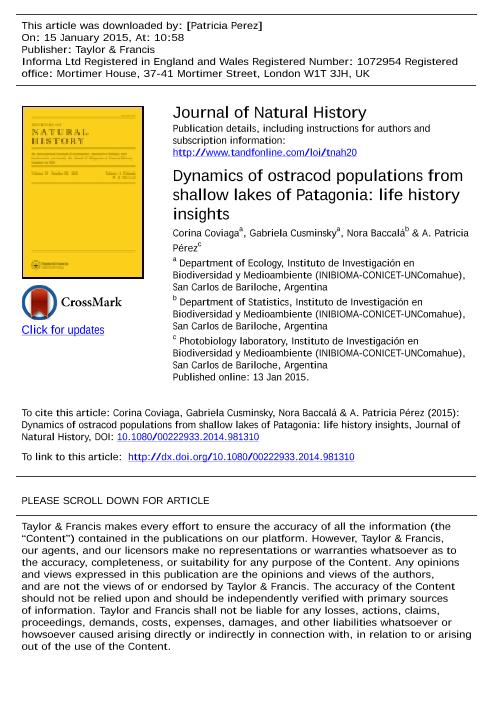Mostrar el registro sencillo del ítem
dc.contributor.author
Coviaga, Corina Anabel

dc.contributor.author
Cusminsky, Gabriela Catalina

dc.contributor.author
Baccalá, Nora Belkis

dc.contributor.author
Peréz, Patricia
dc.date.available
2018-08-10T18:33:52Z
dc.date.issued
2015-05
dc.identifier.citation
Coviaga, Corina Anabel; Cusminsky, Gabriela Catalina; Baccalá, Nora Belkis; Peréz, Patricia; Dynamics of ostracod populations from shallow lakes of Patagonia: life history insights; Taylor & Francis; Journal of Natural History; 49; 17-18; 5-2015; 1023-1045
dc.identifier.issn
0022-2933
dc.identifier.uri
http://hdl.handle.net/11336/54986
dc.description.abstract
Wetlands are one of the most valuable natural resources, providing a number of ecosystem services and socio-economic values. Small ponds sustain a rich aquatic biodiversity and because of their short hydrological regimen and small size are excellent environments for population studies of microcrustaceans such as ostracods. This study describes the population dynamics of the Ostracoda fauna in three temporary shallow lakes during one hydroperiod in Argentine Patagonia. Three cosmopolitan species were determined: Cypris pubera, Tonnacypris lutaria and Eucypris virens. Among them, T. lutaria is here reported for the first time from the Neotropical region. Multivariate ordination techniques were used to examine the relationships among environmental variables and ostracod density on each sampling site. High values of conductivity, absorption at 320 nm (as a measure of dissolved organic matter), dissolved oxygen concentration, temperature and chlorophyll a concentration correlated positively with ostracod density. All the populations studied reproduced parthenogenetically, and the life cycles of E.virens and C. pubera were followed in detail by weekly sampling of their populations. The former displayed continuous reproduction, whereas the latter showed a multivoltine strategy. The life history of C. pubera was affected by the seasonality of the habitat. The development rate correlated positively with water temperature; conductivity and temperature had a positive effect on adult size in C. pubera, while conductivity had a negative effect on adult size in E. virens. In this study, we present the first data set on the development and life history of ostracods in Patagonian freshwater environments. However, several questions remain and encourage us to further investigate the relative importance of ostracods in food webs, as well as the importance of inter-specific interactions between ostracods and other taxa.
dc.format
application/pdf
dc.language.iso
eng
dc.publisher
Taylor & Francis

dc.rights
info:eu-repo/semantics/openAccess
dc.rights.uri
https://creativecommons.org/licenses/by-nc-sa/2.5/ar/
dc.subject
Development
dc.subject
Life Cycle
dc.subject
Microcrustacean
dc.subject
Wetlands
dc.subject.classification
Paleontología

dc.subject.classification
Ciencias de la Tierra y relacionadas con el Medio Ambiente

dc.subject.classification
CIENCIAS NATURALES Y EXACTAS

dc.title
Dynamics of ostracod populations from shallow lakes of Patagonia: life history insights
dc.type
info:eu-repo/semantics/article
dc.type
info:ar-repo/semantics/artículo
dc.type
info:eu-repo/semantics/publishedVersion
dc.date.updated
2018-08-08T14:10:42Z
dc.journal.volume
49
dc.journal.number
17-18
dc.journal.pagination
1023-1045
dc.journal.pais
Reino Unido

dc.journal.ciudad
Londres
dc.description.fil
Fil: Coviaga, Corina Anabel. Consejo Nacional de Investigaciones Científicas y Técnicas. Centro Científico Tecnológico Conicet - Patagonia Norte. Instituto de Investigaciones en Biodiversidad y Medioambiente. Universidad Nacional del Comahue. Centro Regional Universidad Bariloche. Instituto de Investigaciones en Biodiversidad y Medioambiente; Argentina
dc.description.fil
Fil: Cusminsky, Gabriela Catalina. Consejo Nacional de Investigaciones Científicas y Técnicas. Centro Científico Tecnológico Conicet - Patagonia Norte. Instituto de Investigaciones en Biodiversidad y Medioambiente. Universidad Nacional del Comahue. Centro Regional Universidad Bariloche. Instituto de Investigaciones en Biodiversidad y Medioambiente; Argentina
dc.description.fil
Fil: Baccalá, Nora Belkis. Consejo Nacional de Investigaciones Científicas y Técnicas. Centro Científico Tecnológico Conicet - Patagonia Norte. Instituto de Investigaciones en Biodiversidad y Medioambiente. Universidad Nacional del Comahue. Centro Regional Universidad Bariloche. Instituto de Investigaciones en Biodiversidad y Medioambiente; Argentina
dc.description.fil
Fil: Peréz, Patricia. Consejo Nacional de Investigaciones Científicas y Técnicas. Centro Científico Tecnológico Conicet - Patagonia Norte. Instituto de Investigaciones en Biodiversidad y Medioambiente. Universidad Nacional del Comahue. Centro Regional Universidad Bariloche. Instituto de Investigaciones en Biodiversidad y Medioambiente; Argentina
dc.journal.title
Journal of Natural History

dc.relation.alternativeid
info:eu-repo/semantics/altIdentifier/doi/http://dx.doi.org/10.1080/00222933.2014.981310
dc.relation.alternativeid
info:eu-repo/semantics/altIdentifier/url/https://www.tandfonline.com/doi/abs/10.1080/00222933.2014.981310
Archivos asociados
